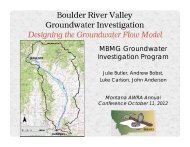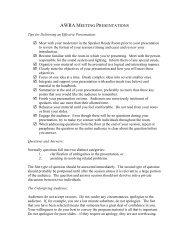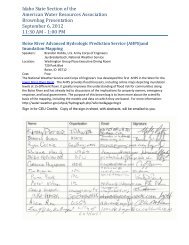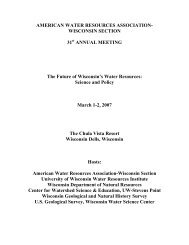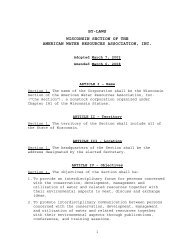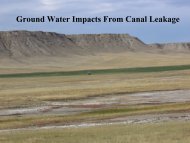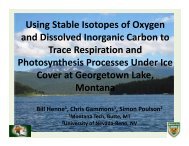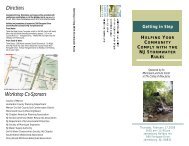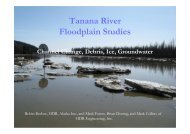Wisconsin's Role in Great Lakes Restoration - American Water ...
Wisconsin's Role in Great Lakes Restoration - American Water ...
Wisconsin's Role in Great Lakes Restoration - American Water ...
Create successful ePaper yourself
Turn your PDF publications into a flip-book with our unique Google optimized e-Paper software.
Climate Variability and Groundwater Recharge <strong>in</strong> Southwest Wiscons<strong>in</strong><br />
Madel<strong>in</strong>e B. Gotkowitz, Wiscons<strong>in</strong> Geological and Natural History Survey, Madison, WI<br />
Doug R. Joachim, Dept. of Civil and Environmental Eng<strong>in</strong>eer<strong>in</strong>g, UW – Madison, Madison, WI<br />
Steven J. Vavrus, Gaylord Nelson Institute of Environmental Study, UW- Madison, Madison,<br />
WI<br />
Steven P. Loheide lI, Dept. of Civil and Environmental Eng<strong>in</strong>eer<strong>in</strong>g, UW – Madison, Madison,<br />
WI<br />
Kenneth R. Bradbury, Wiscons<strong>in</strong> Geological and Natural History Survey, Madison, WI<br />
Record precipitation <strong>in</strong> 2007 and 2008 contributed to widespread groundwater flood<strong>in</strong>g near<br />
Spr<strong>in</strong>g Green, WI, and caused over $17 million <strong>in</strong> economic losses. About $8.5 million will be<br />
<strong>in</strong>vested <strong>in</strong> the area to mitigate such flood<strong>in</strong>g and high water table conditions. We assessed<br />
the utility of flood mitigation efforts by simulat<strong>in</strong>g future changes to recharge and water table<br />
elevation. In this evaluation, eight statistically-downscaled global circulation models (GCMs)<br />
predict daily values of precipitation, temperature, and relative humidity. These provide the<br />
basis for the soil water balance model, which produces daily estimates of runoff and<br />
<strong>in</strong>filtration. Infiltration is applied as recharge to the water table <strong>in</strong> a transient groundwater<br />
model of the region. Model simulations from 1981-2000 provide a base case for comparison<br />
to predictions from future periods of 2046-2065 and 2081-2100.<br />
Results show that while recharge may decrease on average, the variability <strong>in</strong> annual recharge<br />
may lead to occasional years of high groundwater levels. Under the base case, annual<br />
recharge averages 14.1 <strong>in</strong>ches across the model doma<strong>in</strong>. Despite a general <strong>in</strong>crease <strong>in</strong><br />
precipitation dur<strong>in</strong>g both future climate periods of 2.3 <strong>in</strong>ches, simulated average annual<br />
groundwater recharge decreases 0.6 <strong>in</strong>ches by 2065 and decreases an additional 1.5 <strong>in</strong>ches<br />
by 2100. The simulated decrease <strong>in</strong> average recharge is driven by <strong>in</strong>creas<strong>in</strong>g annual<br />
temperatures and a result<strong>in</strong>g <strong>in</strong>crease <strong>in</strong> simulated evapotranspiration. However, this set of<br />
eight GCMs leads to a broad range <strong>in</strong> annual recharge, with the range <strong>in</strong> recharge vary<strong>in</strong>g<br />
from no change from the base case to a decrease of over 7.5 <strong>in</strong>ches per year. High<br />
groundwater levels may <strong>in</strong>deed become more common despite drier conditions overall, as<br />
suggested by a positively skewed frequency distribution of annual recharge. These results<br />
suggest that preserv<strong>in</strong>g current land use <strong>in</strong> Spr<strong>in</strong>g Green may require implementation of the<br />
proposed mitigation efforts.<br />
<br />
57






